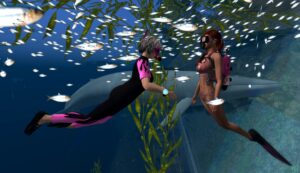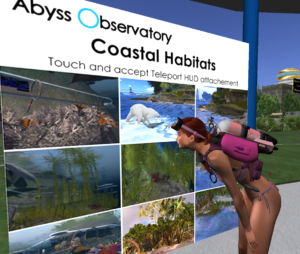
I sometimes forget that Second Life is a scientific laboratory for the computer scientist. The 3D world that I take for granted is the product of many, many talented programmers and mathematicians. I could program in C and FORTRAN but object oriented, windows-based programming always eluded me, so I am most impressed with the virtual world of Second Life.
Along with the programmers that create the world, lesser mortals can build objects and environments using the tools provided. I’m pretty hopeless at building too, so I sought out Delia Lake to inquire about her building strategies and techniques.
Last month, I featured Delia, an environmental scientist, in this column (See Staring into the Abyss). This time I went back to her to learn how she created the wonderful underwater and coastal locations that make up a large part of the Abyss Observatory.
Delia has built many habitats at Abyss.
- Tropical marine — coral reefs and marine animals that live in or migrate through those environments
- Tropical coast — mangrove forest
- Temperate marine — kelp forest and marine animals that live in that environment
- Temperate coastal marine oak and holly forest — endangered
- Temperate coastal rain forest
- Sub-Arctic marine and cold water coral reef and arctic marine animals
- Sub-Arctic coastal tundra and animals
- Tundra and forest fire in the Arctic

Delia came to SL early on and has built a number of environments. “I started building environmental habitats in SL in the Autumn of 2006 at the Center for Water Studies on Better World Island. Over a number of years there I build out the tropical, temperate, and arctic marine habitats. I also build a representation of The Wild Coast of eastern South Africa. We added a second sim, Meloria Terra, which I build out as 3 prairie habitats: past, present, and future. We had tepees and minimal habitat disturbance on the past, heavy disturbance and soil depletion on the present, and restorative agriculture on the future. Sadly these regions are now gone.”
“I also did landscaping and had a whole region on Al Andalus, now also gone into the SL history books. I have done much of the landscaping for the six region Confederation of Democratic Simulators (C.D.S.), the community in SL where I live.”
So, how does one create an environment in SL? Delia said, “I had to learn some building skills in SL but these days, more than build from scratch, I adjust things other people have built, so I change sizes, colors and textures and sometimes modify scripts when I need to to make them more realistic.”
“More than building skills though I rely on my knowledge of different RL habitats, some that I’ve visited and others where I know people who have done extensive research. I also rely on my skill at pattern thinking — how things fit together, how they interact and how those interactions change the composition and balance.”
“I ask myself what is essential in a SL habitat to have it be sufficient to be representative of a RL habitat even though it is not complete. It is not possible to duplicate a RL habitat in its totality but what does one need to make it simulate that kind of habitat? So each of my environmental builds have both predator and prey species. Each has some vegetation to represent the different kinds of groupings there might be, so low ground cover, shrubs or bushes, and trees when appropriate. I never mix species that could not live together under the same conditions. So for instance no snowy spruces mixed with palms. I would never put tropical fish in an arctic marine build. Also, people have asked why no penguins? Penguins are Antarctic birds and do not live in the Arctic. This gives a sense of actually experiencing a place even though it is not complete with everything that one would find in the RL habitat of that kind.”

The Abyss Observatory is the product of many scientists. Delia explains, “I collaborate with Yan Luria, and also sometimes with Veritas Raymaker on builds at the Abyss Observatory. I have also collaborated with makers of animals. Kaikou Splash made animals for me for The Center for Water Studies. John Haskell modified a number of his animals for me when I did a habitat build for Virtually Speaking after the Deep Horizon oil platform explosion that devastated the northern Gulf of Mexico and covered animals with heavy oil and tars.”
For Further Exploration –
- Link to Abyss Observatory Welcome Gallery where you can find links to explore all the habitats.
- This link will land you on the Mediterranean beach of Locus Amoenus where Delia lives. Feel free to walk around the regions from there.
- Deepy is wearing the Bachata bikini from LUXE Paris Fashion House. Her SCUBA gear is from Steelhead Outfitters.
 |
Visits:2
